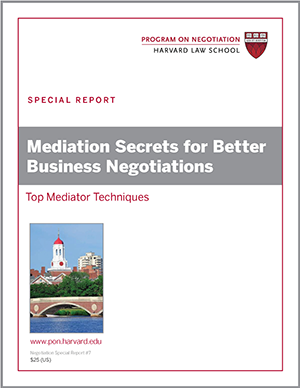
You’ve seen how mediators can help one organizational team prepare for a complex negotiation. But what about when litigation looms?
When faced with a trial, a corporation sometimes engages one law firm to represent it in court and a second law firm to explore settlement possibilities.
According to conventional wisdom, the second law firm should be more capable than the first of dispassionately assessing the parties’ legal strengths and weaknesses and communicating that view to the client, which can then determine an appropriate settlement position.
Yet many negotiation experts would argue that reaching settlement is less a matter of determining which disputant is “right” (or more likely to prevail in court) and more a matter of exploring disputants’ underlying needs or interests in search of a mutually agreeable settlement. This approach to resolving disputes is not necessarily the strength of law firms – but it is a core competency of experienced mediators.
Thus, an organization faced with significant litigation should not content itself with obtaining legal advice to determine its settlement posture. It should also employ an experienced mediator for assistance in:
- uncovering its interests in the pending litigation
- prioritizing those interests
- thinking about the interests and likely priorities of the other parties
- and developing an organizational settlement position that accounts for these issues.
Related Article: Undecided on Your Alternative Dispute Resolution Process? Combine Mediation and Arbitration with Med-Arb – When you need to choose the right dispute resolution process to resolve your conflict, you might be torn between mediation and arbitration. In this article, a fusion of each process is offered called Med-Arb, a process that seeks to combine the best of mediation and arbitration to resolve your conflict.





La médiation, une posture : libérer la parole, les émotions, faire entendre les positions, sans prendre position, pour favoriser l’émergence de solutions…un consensus acceptable est à ce prix.